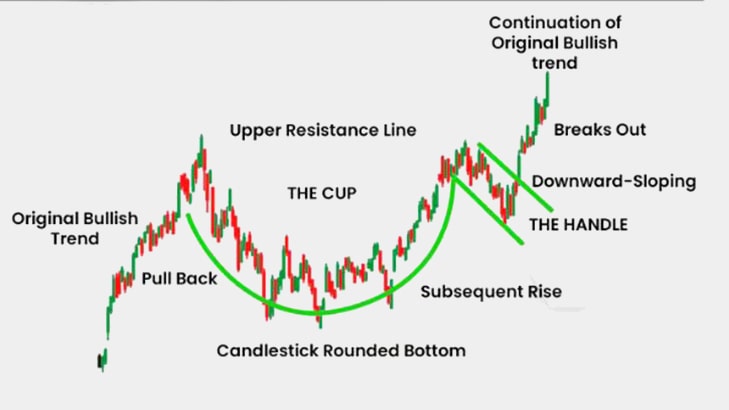
The Cup and Handle chart pattern is a bullish continuation pattern that can indicate a potential upward trend continuation after a period of consolidation. Here’s how it’s typically identified:
Cup Formation: The pattern starts with a rounded bottom formation, resembling a cup or a bowl. This phase often forms after a prolonged downtrend or consolidation period. During this phase, the price gradually decreases and then stabilizes, forming the bottom of the cup.
Handle Formation: Following the completion of the cup formation, there is usually a short-term consolidation or retracement in the price, forming a smaller downward movement. This forms the handle of the pattern, which is typically shorter in duration compared to the cup formation.
Breakout: The pattern is considered complete when the price breaks out above the resistance level formed by the high point of the cup formation. This breakout is typically accompanied by increased volume, indicating a surge in buying interest.
Key characteristics of the Cup and Handle pattern:
- Volume: Generally, the volume tends to decrease during the formation of the cup and handle pattern and then increases during the breakout, confirming the bullish bias.
- Duration: The entire pattern, including the cup and handle formation, can take several weeks to months to develop fully.
- Symmetry: The cup formation should be relatively symmetrical, without any abrupt or V-shaped bottoms.
- Handle Depth: The handle formation typically retraces around one-third to two-thirds of the cup’s advance but should not decline significantly below the cup’s low point.
Trading the Cup and Handle pattern often involves entering a long (buy) position once the price breaks out above the resistance level formed by the cup’s high point. Traders may place a stop-loss order below the handle’s low point to manage risk.
As with any technical pattern, it’s essential to consider other factors such as market conditions, fundamental analysis, and risk management principles before making trading decisions based solely on the Cup and Handle pattern. Additionally, it’s always a good practice to wait for confirmation of the breakout before entering a trade.

कप और हैंडल चार्ट पैटर्न एक तेजी से जारी रहने वाला पैटर्न है जो समेकन की अवधि के बाद संभावित ऊपर की ओर रुझान जारी रहने का संकेत दे सकता है। यहां बताया गया है कि इसे आम तौर पर कैसे पहचाना जाता है:
- कप निर्माण: पैटर्न एक गोल तली संरचना से शुरू होता है, जो एक कप या कटोरे जैसा दिखता है। यह चरण अक्सर लंबे समय तक डाउनट्रेंड या समेकन अवधि के बाद बनता है। इस चरण के दौरान, कीमत धीरे-धीरे कम हो जाती है और फिर स्थिर हो जाती है, जिससे कप का निचला भाग बनता है।
- हैंडल का गठन: कप के गठन के पूरा होने के बाद, आमतौर पर कीमत में एक अल्पकालिक समेकन या रिट्रेसमेंट होता है, जिससे नीचे की ओर एक छोटी गति बनती है। यह पैटर्न का हैंडल बनाता है, जो आमतौर पर कप निर्माण की तुलना में अवधि में छोटा होता है।
- ब्रेकआउट: पैटर्न को पूर्ण माना जाता है जब कीमत कप गठन के उच्च बिंदु द्वारा गठित प्रतिरोध स्तर से ऊपर टूट जाती है। यह ब्रेकआउट आम तौर पर बढ़ी हुई मात्रा के साथ होता है, जो खरीदारी में रुचि बढ़ने का संकेत देता है।
कप और हैंडल पैटर्न की मुख्य विशेषताएं:
वॉल्यूम: आम तौर पर, कप और हैंडल पैटर्न के निर्माण के दौरान वॉल्यूम कम हो जाता है और फिर ब्रेकआउट के दौरान बढ़ जाता है, जो तेजी के पूर्वाग्रह की पुष्टि करता है।
अवधि: कप और हैंडल गठन सहित पूरे पैटर्न को पूरी तरह से विकसित होने में कई सप्ताह से लेकर महीनों तक का समय लग सकता है।
समरूपता: कप का गठन अपेक्षाकृत सममित होना चाहिए, बिना किसी अचानक या वी-आकार के तल के।
हैंडल की गहराई: हैंडल का गठन आम तौर पर कप की प्रगति के लगभग एक-तिहाई से दो-तिहाई तक पीछे रह जाता है, लेकिन कप के निम्न बिंदु से नीचे महत्वपूर्ण रूप से गिरावट नहीं होनी चाहिए।
कप और हैंडल पैटर्न का व्यापार करने में अक्सर एक लंबी (खरीद) स्थिति में प्रवेश करना शामिल होता है जब कीमत कप के उच्च बिंदु द्वारा गठित प्रतिरोध स्तर से ऊपर हो जाती है। जोखिम को प्रबंधित करने के लिए व्यापारी हैंडल के निचले बिंदु के नीचे स्टॉप-लॉस ऑर्डर लगा सकते हैं।
किसी भी तकनीकी पैटर्न की तरह, केवल कप और हैंडल पैटर्न के आधार पर व्यापारिक निर्णय लेने से पहले बाजार की स्थितियों, मौलिक विश्लेषण और जोखिम प्रबंधन सिद्धांतों जैसे अन्य कारकों पर विचार करना आवश्यक है। इसके अतिरिक्त, किसी व्यापार में प्रवेश करने से पहले ब्रेकआउट की पुष्टि की प्रतीक्षा करना हमेशा एक अच्छा अभ्यास है।







